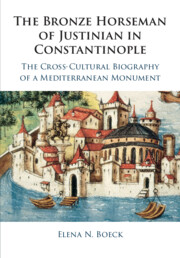 The Bronze Horseman of Justinian in Constantinople
The Bronze Horseman of Justinian in Constantinople Book contents
- The Bronze Horseman of Justinian in Constantinople
- The Bronze Horseman of Justinian in Constantinople
- Copyright page
- Contents
- Figures and Maps
- Tables
- Acknowledgements
- Abbreviations
- Note on Transliteration and Naming Conventions
- Selected Timeline of the Triumphal Column of Justinian and Its International Reverberations
- Map of Constantinople
- Introduction
- 1 Justinian’s Entry into Constantinople: He Came, He Saw, He Conquered
- 2 The Making of Justinian’s Forum
- 3 Defying a Defining Witness: the Bronze Horseman and the Buildings (De Aedificiis) of Prokopios
- 4 The Horseman of Baghdad Responds to the Horseman of Constantinople
- 5 Soothing Imperial Anxieties: Theophilos and the Restoration of Justinian’s Crown
- 6 Debating Justinian’s Merits in the Tenth Century
- 7 The Bronze Horseman and a Dark Hour for Humanity
- 8 The Horseman Becomes Heraclius: crusading Narratives of the Eleventh and Twelfth Centuries
- 9 From Exile in Nicaea to Restoration of Constantinople
- 10 A Learned Dialogue across the Ages: Pachymeres Confronts Prokopios
- 11 Orb-Session: Constantinople’s Future in the Bronze Horseman’s Hand
- 12 Justinian’s Column and the Antiquarian Gaze: a Centuries-Old “Secret” Exposed
- 13 A Timeless Ideal: Constantinople in Slavonic Imagination of the Fourteenth–Fifteenth Centuries
- 14 The Horseman Meets Its End
- 15 Horse as Historia, Byzantium as Allegory
- 16 Shadowy Past and Menacing Future
- 17 After the Fall: the Bronze Horseman and the Eternal Tsar’grad
- Postscript: the Horseman’s Debut in Print
- Select Bibliography
- Index
7 - The Bronze Horseman and a Dark Hour for Humanity
Published online by Cambridge University Press: 08 April 2021
- The Bronze Horseman of Justinian in Constantinople
- The Bronze Horseman of Justinian in Constantinople
- Copyright page
- Contents
- Figures and Maps
- Tables
- Acknowledgements
- Abbreviations
- Note on Transliteration and Naming Conventions
- Selected Timeline of the Triumphal Column of Justinian and Its International Reverberations
- Map of Constantinople
- Introduction
- 1 Justinian’s Entry into Constantinople: He Came, He Saw, He Conquered
- 2 The Making of Justinian’s Forum
- 3 Defying a Defining Witness: the Bronze Horseman and the Buildings (De Aedificiis) of Prokopios
- 4 The Horseman of Baghdad Responds to the Horseman of Constantinople
- 5 Soothing Imperial Anxieties: Theophilos and the Restoration of Justinian’s Crown
- 6 Debating Justinian’s Merits in the Tenth Century
- 7 The Bronze Horseman and a Dark Hour for Humanity
- 8 The Horseman Becomes Heraclius: crusading Narratives of the Eleventh and Twelfth Centuries
- 9 From Exile in Nicaea to Restoration of Constantinople
- 10 A Learned Dialogue across the Ages: Pachymeres Confronts Prokopios
- 11 Orb-Session: Constantinople’s Future in the Bronze Horseman’s Hand
- 12 Justinian’s Column and the Antiquarian Gaze: a Centuries-Old “Secret” Exposed
- 13 A Timeless Ideal: Constantinople in Slavonic Imagination of the Fourteenth–Fifteenth Centuries
- 14 The Horseman Meets Its End
- 15 Horse as Historia, Byzantium as Allegory
- 16 Shadowy Past and Menacing Future
- 17 After the Fall: the Bronze Horseman and the Eternal Tsar’grad
- Postscript: the Horseman’s Debut in Print
- Select Bibliography
- Index
Summary
The only surviving Byzantine image of the horseman inhabits an ominous and foreboding landscape. The unique image appears in an illustrated version of the Book of Job. The horseman presides over a darkly emotional and philosophically rich scene (Vat. Gr. 751, fol. 26r). The artist who created this image transported the horseman back in time to have it preside over the darkest moment in the trials of virtuous Job caught up in a contest between forces far greater than himself. Given that the motif of fall permeates the Book of Job, our image metaphorically envisions a bitter estrangement from the Queen of Cities. In this unique image of Job, Justinian’s column is multivalent. It is both triumphal and tragic. If it were not juxtaposed with Job’s suffering it would seem celebratory. However, the juxtaposition is central. The horseman is poised to witness how the righteous suffer as a result of a cosmic battle between good and evil. Either the manuscript’s creator was very prescient in forecasting Job-like tribulations for Constantinople or he was operating with hindsight at some point after the Crusader capture of Constantinople in 1204.
- Type
- Chapter
- Information
- The Bronze Horseman of Justinian in ConstantinopleThe Cross-Cultural Biography of a Mediterranean Monument, pp. 155 - 168Publisher: Cambridge University PressPrint publication year: 2021
